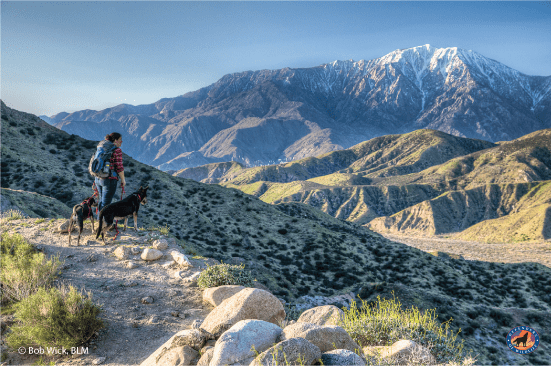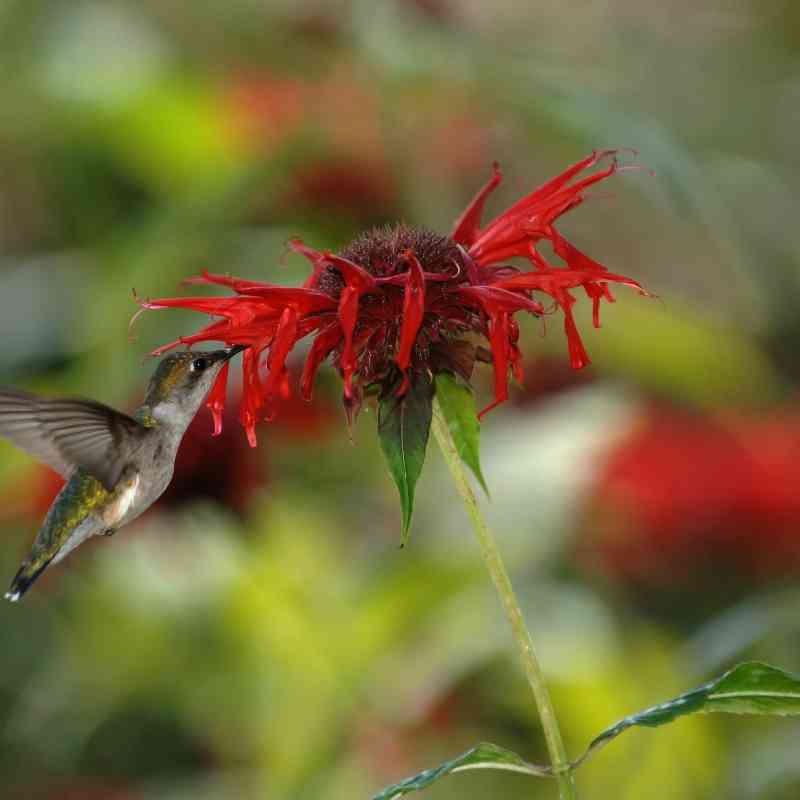Seven of California’s national monuments are under “review” as a result of President Trump’s executive order leveling an all-out assault on our public lands.
In April, the Carrizo Plain National Monument, located in a remote area east of San Luis Obispo, California, erupted with wildflowers in an occasional event known as a “super bloom.” Bob Wick, with the Bureau of Land Management, wrote on the agency’s Flickr page that “(t)he Valley floor has endless expanses of yellows and purples from coreopsis, tidy tips and phacelia, with smaller patches of dozens of other species … (And) the Temblor Range is painted with swaths of orange, yellow and purple like something out of a storybook. I have never seen such a spectacular array of blooms. Ever.”
The Carrizo Plain National Monument is one of seven California national monuments under review by the U.S. Department of the Interior to determine if they should remain as designated, or if their boundaries or management should be changed by the federal government. This unprecedented review, ordered by President Trump, affects 27 national monuments designated under the Antiquities Act of 1906.
 California’s seven national monuments under review are special places and must remain protected. These areas were designated after years of community-based organizing, extensive effort to detail the specific historical, cultural and ecological values that make these areas meet the strict criteria for monument designation, and broad public outreach efforts. These lands receive overwhelming public support from the local community and stakeholders. After monument designation, collaborative efforts continue with the monument management planning process involving all stakeholders, particularly the local communities around the monuments.
California’s seven national monuments under review are special places and must remain protected. These areas were designated after years of community-based organizing, extensive effort to detail the specific historical, cultural and ecological values that make these areas meet the strict criteria for monument designation, and broad public outreach efforts. These lands receive overwhelming public support from the local community and stakeholders. After monument designation, collaborative efforts continue with the monument management planning process involving all stakeholders, particularly the local communities around the monuments.
In California, the president’s Executive Order affects seven national monuments—the most of any state with monuments under review. These seven monuments are widely supported by both Californians and most Americans. Many include lands sacred to Native American Tribes or capture historic locales celebrating our American legacy. Others provide invaluable cultural, scientific and recreational resources that provide immeasurable social, economic and ecosystem protection benefits to local communities. These monuments provide habitat for some of California’s most iconic wildlife, including the California condor, desert tortoise, and San Joaquin kit fox. They are places for both Americans and global visitors to reconnect with nature and recreate.
The Berryessa Snow Mountain National Monument is located in California’s Inner Coast Range. It is the best place in the world to see and understand plate tectonics and lies at the intersection of the Bay Area and the Klamath-Siskiyou regions—two incredibly diverse ecosystems. The designation preserves a rich Native American cultural history, dating back at least 12,000 years. It offers a wealth of recreational opportunities and has become an important economic engine for many small rural communities in the region. By the time of its designation in 2015, the monument was supported by nearby cities and counties, 200 businesses, 60 elected officials, the conservation community, local ranchers and farmers, faith-based organizations, regional Hispanic communities, and local Native American Tribes.
The Mojave Trails and Sand to Snow national monuments stretch along a portion of historic Route 66 and connect Joshua Tree National Park and the San Bernardino National Forest. These monuments were supported by state and local elected officials, business owners, veterans, local faith leaders, anglers, historians, and conservationists. Mojave Trails National Monument, California’s largest national monument, incorporates the historic Mojave Trail, which connects the Colorado River with the California Coast and was trekked by Native Americans for centuries. Franciscan Father Garces discovered this trail in 1776, and pioneering trailblazer Jedidiah Smith followed his footsteps through Afton Canyon, or the “Grand Canyon the Mojave” in 1826. The Los Angeles to Salt Lake Railroad, a brainchild of United States Senator William Andrews Clark constructed in 1905; and the Tonopah to Tidewater Railroad, constructed in 1907 by “Borax King” Francis Marion Smith, are also partially encompassed in this national monument. It also stretches along a portion of historic Route 66, also known as the “Main Street of America” or the “Mother Road”, which was one of the original roadways of the United States Highway System.
The Sand to Snow National Monument stretches from the sands of both the Mojave and Colorado deserts to San Gorgonio Peak, the tallest mountain in southern California. It connects a vital wildlife corridor between mountains considered sacred by the Gabrielino, Luiseno and Serrano Indian Tribes. Thirty miles of the Pacific Crest Trail bisect this monument, which supports more than 1,600 plant species dispersed throughout diverse niches between mountain peaks and the desert floor. The monument serves to connect the western portions of the San Bernardino National Forest, San Gorgonio Wilderness, Big Morongo, Whitewater and Mission Creek Preserves, Black Lava Butte and Flat Top Mesa to Joshua Tree National Park.
These California Desert monuments were supported by a wide range of state and local elected officials, business owners, veterans, local faith leaders, anglers, historians, and conservationists. Extensive planning to address local concerns spanned nearly a decade preceding monument designation.

Sand to Snow
Both Mojave and Sand to Snow monuments provide essential habitat for well-known wildlife such as the threatened Agassiz’s desert tortoise, California’s state reptile; the endangered peninsular bighorn sheep and closely-related desert bighorn sheep; wide-ranging vulnerable species such the golden eagle; as well as fascinating endemic species, such Coachella Valley and Mojave fringed-toed lizards. Archeological, historic and scientific wonders include the Marble Mountains Fossil Beds, where 550-million-year-old trilobite fossils can be found; the volcanic Pisgah Lava Flow and Amboy Crater National Landmark; the Bigelow Cholla Garden, California’s largest cactus assemblage; General Patton’s World War II Tank Training Camp; and the singing Cadiz Sand Dunes.
The San Gabriel Mountains National Monument, located just a 90-minute drive from the park-poor Los Angeles Basin, offers vast expanses of largely undeveloped forest and alpine landscape, four wilderness areas, streams and rivers with incredible opportunities for fishing, picnicking, and camping Its mountain streams and forests serve as a critical watershed for Southern California cities and are an important part of the hunting and fishing industry, with more than 100 hunting and fishing organizations opposing any reduction in monument protection or size. Most of the San Gabriel’s major mountain peaks are located within the monument, including Mount San Antonio and Mount Baden-Powell, as well as the striking geological features of the San Andreas Fault and Devil’s Punchbowl. The monument’s diverse habitats support imperiled species such as the endangered California condor, southwestern willow flycatcher, mountain yellow-legged frog and Santa Ana sucker, as well as the California spotted owl, mountain lion, black bear and desert bighorn sheep.
The Carrizo Plain National Monument protects some of the last remaining intact native grassland in Central California. A land of waving grass and wildflower “super blooms,” it is home to several animals of significant conservation importance such as pronghorn antelope, which has been extirpated in much of California; tule elk, a unique subspecies once wiped out in the state and which has recovered from a single breeding pair; and both the endangered San Joaquin kit fox, and the world’s largest bird, the California condor.
Giant Sequoia National Monument boasts half of all the giant sequoias in the world, including 38 of 39 groves in Sequoia National Forest. Thousands of families visit these lands each year to marvel at the largest living organisms on Earth which have spanned the centuries; some to ages of 3,000 years or more. This ancient forest supports the imperiled Pacific fisher and California spotted owl, as well as mountain lion, bobcat and black bear; with the southern portion of the monument partially surrounding the Tule River Indian Reservation.
One of the most biologically diverse ecosystems of the Cascade Range, the Cascade-Siskiyou National Monument straddles the border between California and Oregon where the Klamath, Siskiyou, and Cascade mountain ranges converge, setting the stage for a unique mixing of diverse habitats in a small area. An intriguing mosaic of grasslands, oak woodlands, juniper scrub, chaparral, dry pine forest, moist fir forest, meadows, wetlands and volcanic rock outcrops support the endangered Gentner’s fritillary and great gray owl, the threatened northern spotted owl, Oregon spotted and yellow-legged frogs, redband trout, Roosevelt elk, American pika and more here. The historic Applegate Trail and California branch of the Oregon Trail are also encompassed by this monument, which was supported by local communities, businesses, Native American Tribes, conservation organizations, hunting and fishing groups.
California Strong
These seven monuments represent the best of California’s wildlife and wild places and are broadly supported. Mirroring the strong public support for continued protection of these monuments in California, the state Legislature passed Assembly Joint Resolution 15 in June. This resolution called on Congress and the president to respect and protect California’s seven monuments currently under review. Interior Secretary Ryan Zinke should listen to the wishes of the overwhelming majority of Californians and people throughout the country who love their national monuments and want them to remain intact and protected for future generations.
Help us speak up for our wildlife and wild places. Tell Secretary Zinke that America’s national monuments belong to all of us and should be preserved as designated under the Antiquities Act!
 Download our California monuments print-out and our 27 monuments print-out to help us spread the word about this potentially disastrous attack on our cherished wild places and the wildlife that call these places home.
Download our California monuments print-out and our 27 monuments print-out to help us spread the word about this potentially disastrous attack on our cherished wild places and the wildlife that call these places home.
Follow us on social media to stay up-to-date on the status of these at-risk national monuments and other developments important to wildlife conservation and our work. Don’t forget to sign up for our emails where you will get all the latest news and action alerts to support wildlife.
Author
comments










